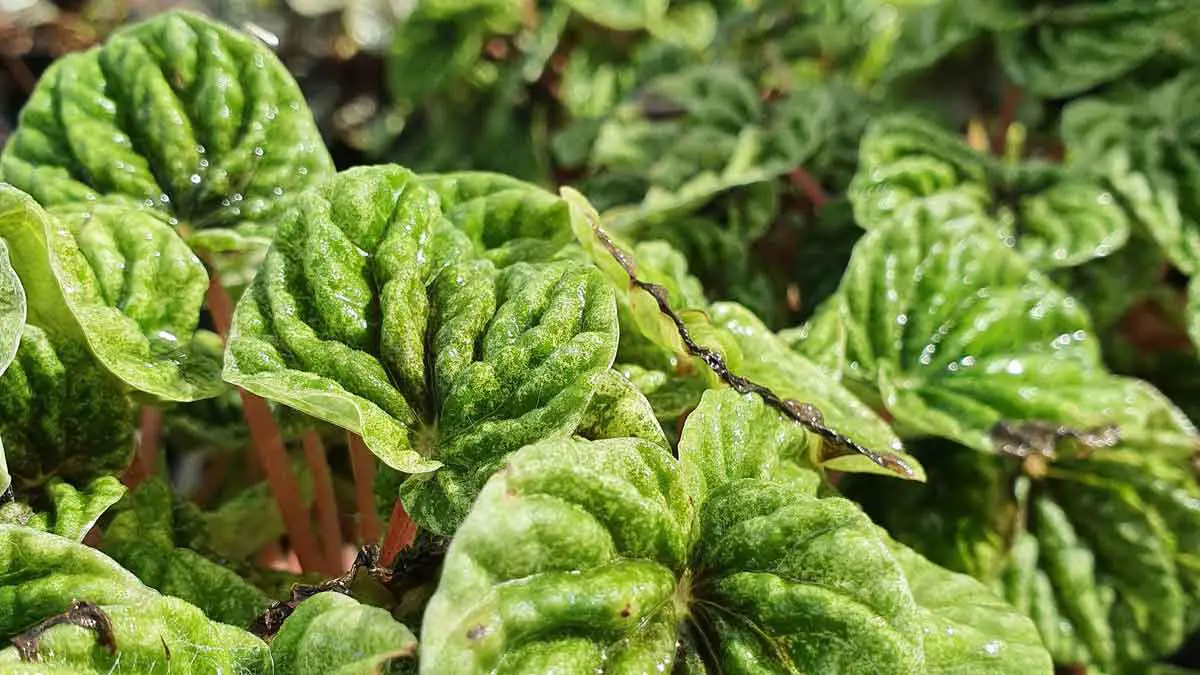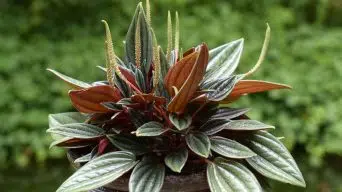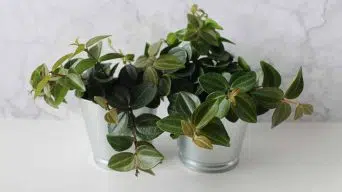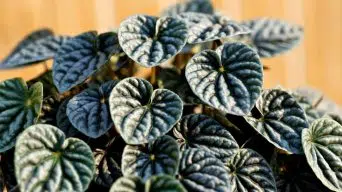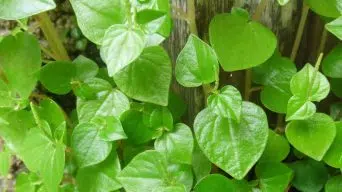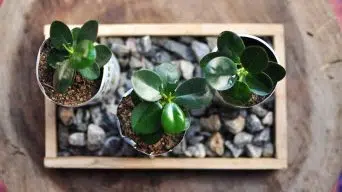Peperomia plants are popular houseplants that are relatively easy to care for. However, they can be susceptible to overwatering, leading to several problems.
An overwatered peperomia will typically have wilted, yellowed, or drooping leaves. The leaves may also be small or have brown spots. The stem may be soft and spongy, and the plant may be overall stunted in growth.
If you think your peperomia is overwatered, it’s essential to take action immediately. If left untreated, overwatering can lead to root rot, which can be fatal to the plant.
In this article, you’ll find out how to identify an overwatered peperomia, treat it, and prevent it from happening in the first place.
What Are the Risks of Overwatering a Peperomia?
Overwatering is a common problem with houseplants, and peperomias are no exception.
When a peperomia plant is overwatered, the roots become waterlogged and can’t get the oxygen they need to function correctly.
This can lead to several problems, including:
Root Rot
This is the most severe problem that can occur due to overwatering.
Root rot is caused by a fungus that attacks the roots and quickly spreads to the rest of the plant.
Once root rot sets in, it’s challenging to treat, and the plant will often die.
When a plant has root rot, the roots won’t be able to absorb water or nutrients, so the plant will start to wilt, and the leaves will turn yellow. The stem may also become soft and spongy.
Root rot can be fatal to peperomias, so taking action as soon as you suspect your plant has it is essential.
Fungal Diseases
Overwatering can lead to other fungal diseases, such as powdery mildew and leaf spot.
Powdery mildew is a white or gray powder covering the plant’s leaves. It’s most commonly found in humid environments.
Small brown spots on the leaves characterize leaf spot. These spots can eventually turn into large patches that cover the entire leaf.
Both of these diseases are caused by fungi that thrive in moist environments. They can weaken the plant and make it more susceptible to other problems.
Bacterial Diseases
Bacterial diseases, such as bacterial blight and bacterial leaf spot, can also be caused by overwatering.
There are small black or brown spots on the leaves of plants affected by bacterial blight. These spots can eventually turn into large patches that cover the entire leaf.
Bacterial leaf spot is similar to fungal leaf spot, but bacteria instead of fungi cause it. It’s characterized by small brown spots on the leaves that can eventually turn into large patches.
These diseases can weaken the plant and make it more susceptible to other problems.
Pest Infestations
Overwatering can also make peperomias more susceptible to pest infestations, such as aphids, mealybugs, and spider mites.
Aphids are small, soft-bodied insects that suck the sap out of plants. They can cause stunted growth and deformities in leaves and stems.
Mealybugs are small, white insects that feed on the juices of plants. They can cause stunted growth, yellowing leaves, and leaf drop.
Spider mites are tiny spider-like creatures that feed on the sap of plants. They can cause yellowing leaves, stippling (little dots on the leaves), and webbing.
Pest infestations can damage the plant and make it more susceptible to other problems.
How Does Overwatering a Peperomia Occur?
There are a few different ways that overwatering can occur:
Watering Too Often
One of the most common reasons for overwatering is simply watering the plant too often.
Peperomias are drought-tolerant plants and don’t need a lot of water. In general, they should be watered once every 7-10 days.
When the plant is dormant, it can be watered even less frequently during the winter.
If you’re unsure how often to water your peperomia plant, it’s better to err on the side of too little water rather than too much.
Using the Wrong Soil
Another common reason for overwatering is using the wrong type of soil.
Peperomias need well-draining soil that is high in organic matter. If the potting soil doesn’t drain well, the roots can become waterlogged and start to rot.
If you need clarification on whether your potting soil mix is well-draining, you can test it by placing a handful in a jar of water. When soil sinks to the bottom of the jar, it’s well-draining. If it floats to the top, it’s not.
Using the Wrong Pot
Another common reason for overwatering is using the wrong type of pot.
Peperomias need a pot that has drainage holes in the bottom. If the pot doesn’t have drainage holes, the roots can become waterlogged and start to rot.
If you’re unsure whether your pot has drainage holes, you can check it by turning it over and looking at the bottom. You’ll need to find a new pot if there are no holes.
Not Letting the Soil Dry Out Between Waterings
One of the most common reasons for overwatering is not letting the soil dry out between waterings.
You must ensure the soil is dry before you water the plant again. The best way to check is to stick your finger in the soil. If it’s damp, it doesn’t need water. If it’s dry, it does.
Watering With Hard Water
Another common reason for overwatering is watering with hard water.
Hard water contains high levels of minerals, such as calcium and magnesium. These minerals can build up in the soil, making it difficult for the plant to absorb water.
The best way to water a peperomia is with filtered or distilled water. This will remove the minerals from the water and make it easier for the plant to absorb.
You can also let tap water sit for 24 hours before watering the plant. This will give the minerals time to settle to the bottom of the container.
Fertilizing Too Often
Another common reason for overwatering is fertilizing too often.
Peperomias don’t need a lot of fertilizer. Generally, they should be fertilized once a month during the growing season.
Overfertilization can burn the plant’s roots and make it more susceptible to overwatering.
How To Identify If Your Peperomia Is Overwatered?
You need to know the signs of overwatering so you can take action to save your plant.
Identifying the problem early is essential so you can take steps to fix it.
Signs of an Overwatered Peperomia
There are a few different signs that you can look for to determine if your peperomia is overwatered.
The most common signs are:
Yellow Leaves
One of the first signs of overwatering is yellowing leaves.
The peperomia leaves will turn yellow at the tips and edges and then work their way down the plant.
If you see yellowing leaves, it’s a sign that you’re watering the plant too often. When the plant is overwatered, the roots can’t absorb water, and the leaves start to yellow.
Brown Leaves
If the yellowing leaves aren’t fixed, they will eventually turn brown and die.
This is a sign that the plant is severely overwatered and is in danger of dying.
If you see brown leaves, you must immediately take action to save the plant.
Wilting Leaves
Another common sign of overwatering is wilting leaves.
When the plant is overwatered, the roots can’t absorb water, and the leaves start to wilt. The peperomia leaves will become droopy, soft, and even fall off the plant.
If you see wilting leaves, it’s a sign that you’re watering the plant too often. When the plant is overwatered, the roots can’t absorb water, and the leaves start to wilt.
Soft or Mushy Stems
If the plant is overwatered, the stems will become soft or mushy.
This is a sign that the roots are soggy and starting to rot. If you see soft or mushy stems, it’s a sign that the plant is in danger of dying.
Mold or Mildew
If the plant is overwatered, it can start to grow mold or mildew.
Mold and mildew are fungi that grow in damp environments. If you see mold or mildew on the plant or soil, it’s a sign that the plant is overwatered.
Mold and mildew can cause the leaves to yellow and die.
Soggy or Muddy Soil
If the plant is overwatered, the soil will become soggy or muddy.
When the roots can’t absorb water, the excess water will start to pool in the pot.
If you see soggy or muddy soil, it’s a sign that the plant is overwatered.
How To Save an Overwatered Peperomia?
If you think your peperomia is overwatered, there are a few things you can do to save the plant.
The most important thing is to take action immediately. The longer you wait, the more damage will be done and the harder it will be to save the plant.
Here are a few things you can do to save an overwatered peperomia:
1. Stop Watering the Plant
The first thing you need to do is stop watering the plant. If you’re overwatering the plant, the roots are waterlogged and can’t absorb water.
Stopping watering the plant will give the roots a chance to dry out.
2. Let the Soil Dry Out
Once you’ve stopped watering the plant, you must let the soil dry.
Do not water the plant again until the soil is dry to the touch.
You may need to wait a week or more for the soil to dry.
3. Prune the Yellowing or Dead Leaves
If the plant has yellowing or dead leaves, you must remove them.
Use sharp, sterilized scissors to cut off the yellowing or dead leaves.
Make sure to cut the leaves all the way back to the stem.
Removing the yellowing or dead leaves will help the plant to focus its energy on the healthy leaves.
4. Repot the Plant
If the plant is overwatered, the roots may be waterlogged and start to rot. If this is the case, you’ll need to repot the plant.
To repot the Peperomia plant, you’ll need to remove it from its current pot and put it in a new pot with fresh soil.
5. Remove the Affected Roots
If the roots are waterlogged and starting to rot, you’ll need to remove them.
The affected roots will be brown or black and mushy.
Use sharp, sterilized scissors to cut off the affected roots.
You’ll need to remove the plant from its pot and gently remove the affected roots.
Once you’ve removed the affected roots, you can repot the plant in fresh, dry soil.
6. Give the Plant More Light
If the plant is overwatered, it may be because it’s not getting enough light.
Peperomias are tropical plants and need bright indirect light to thrive. If the plant is not getting enough light, it will start to grow long, leggy stems in an attempt to reach the light.
You can move the plant to a brighter location to give it more light.
You can also add artificial lighting, such as grow lights, to give the plant the light it needs.
7. Don’t Fertilize the Plant
If you fertilize an overwatered plant, it can worsen the problem.
Fertilizer contains nutrients that the plant needs to grow. If the plant is overwatered, the roots can’t absorb the nutrients and will build up in the soil.
This can lead to root burn, damaging the roots and killing the plant.
If you think your peperomia is overwatered, it’s best to wait until the plant has recovered before fertilizing it.
How To Prevent Overwatering Peperomia Plants?
The best way to prevent overwatering is to water the plant only when the soil is dry.
To check if the soil is dry, stick your finger in the soil up to the first knuckle. If the soil is dry, it’s time to water the plant.
If the soil is wet, wait a few days and check again.
It’s also a good idea to water the plant in the morning, so the leaves have time to dry before nightfall.
Wet leaves can promote fungal growth and make the plant susceptible to disease.
Another way to prevent overwatering is to use a well-draining potting mix.
A well-draining potting mix will help prevent waterlogging and make it easier for the roots to absorb water.
To make sure your potting mix is well-draining, you can add perlite or vermiculite to the mix.
You can also use a pot with drainage holes to help prevent overwatering.
Water the plant less often if you’re using a pot without drainage holes.
Finally, make sure the pot is the right size for the plant.
A pot that’s too small will dry out quickly, while a pot that’s too big will hold too much water and lead to overwatering.
When repotting a peperomia plant, only move it up one pot size.
For example, if the plant is in a 4-inch pot, move it up to a 5-inch pot.
Moving the plant up more than one pot size can lead to overwatering.
Final Thoughts
Growing peperomia in your home should be a fun and rewarding experience.
However, it’s essential to be aware of the potential for overwatering your indoor plant.
If you think your peperomia is overwatered, take action immediately. The sooner you catch and correct the problem, the better chance your plant has of recovering.
With proper care, peperomia can be a resilient plant that brings life and color to your home for many years.

